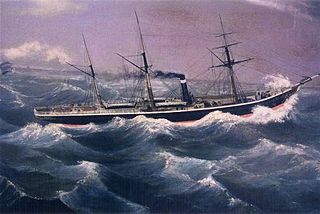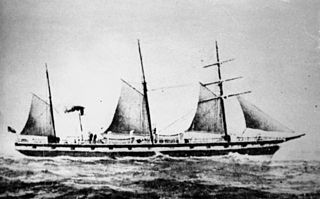
TEV Wahine was a twin-screw, turbo-electric, roll-on/roll-off ferry. Ordered in 1964, the vessel was built by the Fairfield Shipbuilding and Engineering Company, in Govan, Glasgow, Scotland for the Union Steam Ship Company's Wellington-Lyttelton Steamer Express Service in New Zealand.

SS Wairarapa was a New Zealand ship of the late 19th century plying the route between Auckland, New Zealand and Australia. It came to tragic fame when it hit a reef at the northern edge of Great Barrier Island, about 100 km out from Auckland, and sank. The death toll of around 130 people remains one of the largest such losses in the country's history. The ship was named for the Wairarapa region.

General Grant was a 1,005-ton three-masted bark built in Maine in the United States in 1864 and registered in Boston, Massachusetts. It was named after Ulysses S. Grant and owned by Messers Boyes, Richardson & Co. She had a timber hull with a length of 179.5 ft, beam of 34.5 ft and depth of 21.5 ft. While on her way from Melbourne to London, General Grant crashed into a cliff on the west coast of main island of the Auckland Islands of New Zealand, and subsequently sank as a result. Sixty-eight people drowned and only 15 people survived.

SS Republic was a sidewheel steamship, originally named SS Tennessee, lost in a hurricane off the coast of Georgia in October 1865, en route to New Orleans.

SS Penguin was a New Zealand inter-island ferry steamer that sank off Cape Terawhiti after striking a rock near the entrance to Wellington Harbour in poor weather on 12 February 1909. Penguin's sinking caused the deaths of 75 people, leaving only 30 survivors. This was New Zealand's worst maritime disaster of the 20th century.
Sir Charles Hardy Islands is in the reef of the same name adjacent to Pollard Channel & Blackwood Channel about 40 km east of Cape Grenville off Cape York Peninsula.

SS Valencia was an iron-hulled passenger steamer built for the Red D Line for service between Venezuela and New York City. She was built in 1882 by William Cramp and Sons, one year after the construction of her sister ship Caracas. She was a 1,598-ton vessel, 252 feet (77 m) in length. In 1897, Valencia was deliberately attacked by the Spanish cruiser Reina Mercedes off Guantanamo Bay, Cuba. The next year, she became a coastal passenger liner on the U.S. West Coast and served periodically in the Spanish–American War as a troopship to the Philippines. Valencia was wrecked off Cape Beale, which is near Clo-oose, on the west coast of Vancouver Island, British Columbia, on 22 January 1906. As her sinking killed 100 people, some classify the wreck of Valencia as the worst maritime disaster in the "Graveyard of the Pacific", a famously treacherous area off the southwest coast of Vancouver Island.

SS Admella was an Australian passenger steamship that was shipwrecked on a submerged reef off the coast of Carpenter Rocks, south west of Mount Gambier South Australia, in the early hours of 6 August 1859. Survivors clung to the wreck for over a week and many people took days to die as they glimpsed the land from the sea and watched as one rescue attempt after another failed.

The Duncan Dunbar was a clipper constructed for Duncan Dunbar & Company in 1857. It was shipwrecked at the Rocas Atoll off the coast of Brazil on 7 October 1865 on the way to Sydney, Australia.

RMS Quetta was a Royal Mail Ship that was wrecked on the Far North Queensland coast of Australia on 28 February 1890. Quetta's sinking killed 134 of the 292 people on board, making it one of Queensland's biggest maritime catastrophes. It was caused by collision with an uncharted rock in the Adolphus Channel.

SS City of Cairo was a British passenger steamship. She was sunk in the Second World War with heavy loss of life, most after the sinking, but before being rescued.

SS Gothenburg was an iron-hulled sail- and steamship that was built in England in 1854 and sailed between England and Sweden until 1862. She then moved to Australia, where she operated across the Tasman Sea to and from New Zealand until 1873, when she was rebuilt. After her rebuild, she operated in the Australian coastal trade.
Awanui is an historical river port in the far north of New Zealand, on the banks of the Awanui River just before it flows into Rangaunu Bay. Awanui lies at the south end of the Aupouri Peninsula in the Far North District Council of the Northland Region, approximately 7 km north of Kaitaia. The river port has ceased operation and a recreational wharf is located at Unahi, on the shore of Rangaunu Bay, approximately 3 km north of the township. The traditional name of Awanui was Kaiwaka and Awanui proper refers to the "River at Kaiwaka". According to the 2013 New Zealand census, Awanui has a population of 339, a decrease of 9 people since the 2006 census.

A castaway depot is a store or hut placed on an isolated island to provide emergency supplies and relief for castaways and victims of shipwrecks.

The Fitzroy was a steel-hulled steamship built in 1912 at Old Kilpatrick, Scotland in 1912. Thirty-one people were killed when Fitzroy capsized in a gale whilst carrying a general cargo between Coffs Harbour and Sydney off Cape Hawke, New South Wales on 26 June 1921.

The Australasian Steam Navigation Company was a shipping company of Australia which operated between 1839 and 1887.

SS Maloja was an M-class passenger steamship of the Peninsular and Oriental Steam Navigation Company. She was completed in 1911 and worked a regular route between Great Britain and India. In 1916 in the First World War she was sunk by a mine in the English Channel off Dover with the loss of 155 lives.
















